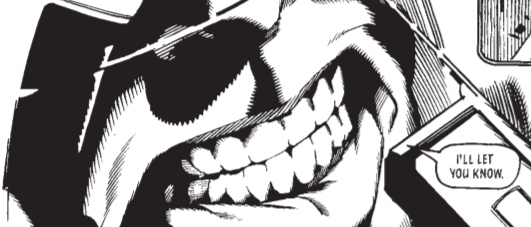(1) WORST: CALIGULA –
JULIO-CLAUDIAN DYNASTY
(37-41 AD: 3 YEARS 10 MONTHS 6 DAYS)
“Would that the Roman people had but one neck”
Ah – Caligula, dreaming of choking out all Rome, the archetype of legendary cruelty and depravity as well as that of the capricious and insane tyrant, so much so that there is a trope of the Caligula named for him (and we all know the type, depressingly frequent in history and culture).
Cue the gag for Caligula learning his capriciousness from Tiberius in Capri.
As I said for Nero, what can I say? You can’t argue with the Gospel of Suetonius, or the Revelations of Bob Guccione in his 1979 Caligula film. Or with the Gospel of Robert Graves which follows Suetonius, or the Revelations of Judge Dredd with Caligula as its Chief Judge Cal in The Day the Law Died.
Also, as I said for Nero, while there may be some issues with the accuracy of sources, particularly the more lurid details recorded by Suetonius, there’s just too much insane smoke for there to have not been an insane fire.
Speaking of Suetonius, if you only read one chapter from Suetonius’ The Twelve Caesars (and it is available free online), then that should be his chapter on Caligula. It’s a hoot! Although I say that from the safe distance of two millennia as well as from Rome itself, because I wouldn’t put it past his ghost or ghoul to get me.
Caligula of course wasn’t his name, but his nickname – uncannily similar to Caracalla subsequently, for an item of clothing worn by each while cosplaying as a soldier, although in Caligula’s case it was his mother cosplaying him as a child in army camps and for his boots rather than a cloak. That’s right – his nickname translates as “Little Boots” or “Bootsy”, which is adorable until he grows up to become emperor.
And you don’t want to make Caligula emperor – you wouldn’t like him when he’s emperor.
Although the sources suggest that people initially did like him as emperor, because among other things, he seems to have ruled well for the first six months until falling sick – “upon recovering, Caligula had permanently lost his hair and apparently his mind”. Or as he perceived it, he had become a divine being. And who’s to say? I can well imagine that’s exactly how a divine being might act when trapped in a mortal form – particularly the divine beings from classical mythology, as it’s how they act a lot of the time. After all, only a god could be that crazy and get away with it.
Anyway, all this sadly suggests that he might have been decent but for sickness making him insane. Or not, I have my doubts – and I note the Gospel of Robert Graves, a.k.a I, Claudius, has him as somewhat psychopathic from the outset.
It’s all there in the sources, particularly Suetonius, which “focus upon his cruelty, sadism, extravagance, and sexual perversion” – “committing incest with his sisters, sending his army against the sea after declaring war on the ocean god Neptune and having them stab the waves and collect shells as booty, marrying a woman who was 9 months pregnant so he wouldn’t have to wait for an heir (whether or not it was his is unclear), using a tax hike upon the birth of his daughter to provide gold for him to roll around in, and wanting to make his favorite horse a consul”.
Also arbitrarily confiscating property in increasingly outrageous for his own spending, punishing citizens for being handsome or having more hair than him, and opening up his palace as a brothel. Actually, I’m with him on that last one.
Indeed, Caligula was so over the top insane that it sometimes seems to be parody or epic trolling – Caligula would rock it on X-Twitter.
I can’t resist quoting The Caligula trope on TV Tropes, given how well it encapsulates, well, THE Caligula:
“The Caligula will be wildly irrational, violently moody, extremely debauched, will never tolerate being told anything they don’t want to hear, and are probably afflicted with a god complex. In short, they will be a Psychopathic Manchild with the power of life or death over everyone whom they can reach. They may be a sexual deviant, or they might take pleasure in the pain and suffering they cause. They may indulge in renaming cities or even the entire country after themself or throwing out increasingly ridiculous decrees with brutal punishments in store for anyone who breaks them. Whatever form the madness takes, one thing is certain: to do anything the Caligula finds displeasing is to inevitably be dragged off to a grisly death or worse. Of course, any number of things might trigger their rage, and they might even decide on a whim to punish those who have not done anything at all”.
EMPIRE DEBAUCHER
The, ah, debauchiest? Well, either him or Elagabalus.
MAXIMUS
Well unless you count Neptune. Caligula should have had a triumph with all the shells
DAMNED
No formal damnatio memoriae but history has damned him
DID DOVAHHATTY DO RIGHT?
The most tongue-in-cheek – and funniest – of Dovahhatty’s mock chad emperors, outright portraying Caligula as the divine chad he saw himself to be, including literally sparring with Neptune. Although again Dovahhatty’s Elagabalus gives his Caligula a run for his denarii – really, they’re the twin peaks of ‘divine’ mad Roman emperors.
RATING: 1 STAR*
F-TIER (WORST-TIER)











